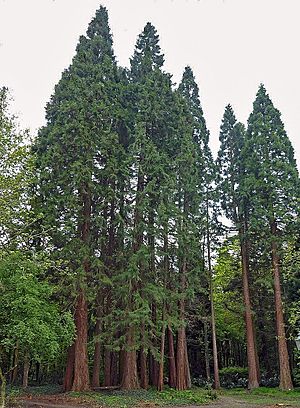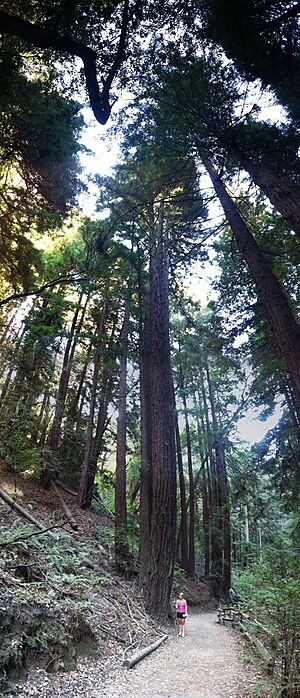Redwood facts for kids
Quick facts for kids Redwood |
|
|---|---|
 |
|
| Sequoiadendron giganteum | |
| Scientific classification |
|
| Kingdom: | Plantae |
| Clade: | Tracheophytes |
| Division: | Pinophyta |
| Class: | Pinopsida |
| Order: | Pinales |
| Family: | Cupressaceae |
| Subfamily: | Sequoioideae |
| Genera | |
|
|
Redwoods are amazing, giant trees! They belong to a group of plants called conifers, which are trees that usually have needles and cones. Redwoods are part of the Cypress family. These trees are famous for being super tall and wide. You can find them mostly in the coastal forests of Northern California. There are three main types of redwoods alive today. Long ago, there were even more kinds, but most of them have disappeared.
Redwoods are special because they can survive forest fires. They have thick bark that protects them from flames. Their cones, which hold their seeds, often open only after a fire. This helps new redwood trees grow. However, because we now control fires better, these trees don't always get the chance to release their seeds. This is one reason why redwoods are now endangered.
Redwood trees can grow to be very large. The biggest type, called Sequoiadendron giganteum, can reach almost 95 meters (312 feet) tall. That's taller than a 30-story building! The tallest tree in the world is believed to be a Sequoia sempervirens named Hyperion. The largest tree by how much wood it contains is a Sequoiadendron giganteum called the General Sherman Tree. It was named after a famous general, William Tecumseh Sherman.
Contents
Where Redwoods Grow
Redwood trees naturally grow in specific places around the world.
Redwoods in China
- The Metasequoia glyptostroboides is found in south-central China. You can see them in areas like Chongqing, Hubei, and Hunan.
Redwoods in California, USA
- The Sequoiadendron giganteum trees only grow on the western side of the Sierra Nevada mountains in California.
- The Sequoia sempervirens trees are found along the Northern California coast. They also grow a few miles into Oregon.
What Redwoods Look Like
The three main types of redwoods are Sequoia, Sequoiadendron, and Metasequoia. Sequoia trees grow along the coast of California and Oregon. Sequoiadendron trees are found in California's Sierra Nevada mountains. Metasequoia trees grow in China.
Redwood species include some of the largest and tallest trees on Earth. These amazing trees can live for thousands of years! However, they face threats like logging, not enough fires, climate change, and people illegally taking parts of the trees.
Only the Sequoia and Sequoiadendron types are known for growing into massive trees. The Metasequoia type, with its single living species Metasequoia glyptostroboides, grows much smaller.
Ancient Redwoods
Redwoods are very old trees, not just in age, but also as a group of plants. The oldest known redwood species was found in rocks from the Jurassic period. This means redwoods have been around for millions of years!
Fossils show that redwoods used to grow in many more places. They were found in the Arctic Circle, Europe, North America, and all over Asia. As the Earth's climate changed and got colder, redwoods started to grow in fewer places. They adapted to survive in certain areas where the conditions were just right.
Protecting Redwoods

All types of redwoods are now endangered. This means they are at risk of disappearing forever. Organizations like the IUCN Red List keep track of how endangered each type is.
Where Redwoods Are Planted Now
Since the early 1800s, people have planted California redwood species in many places outside their natural homes. The Chinese redwood species has been planted more widely since 1948. You can find these trees in botanical gardens, public parks, and private yards all over the world. They grow well in places with similar climates to their native habitats.
Some of these places include other parts of California, the coastal Northwestern United States, the Eastern United States, parts of China, Ireland, Germany, the United Kingdom, Australia, and near Rotorua in New Zealand. People also use them in projects to show what ancient landscapes looked like.
Images for kids
-
Young but already tall redwood trees (Sequoia sempervirens) in Oakland, California.
See also
 In Spanish: Secuoyas para niños
In Spanish: Secuoyas para niños



